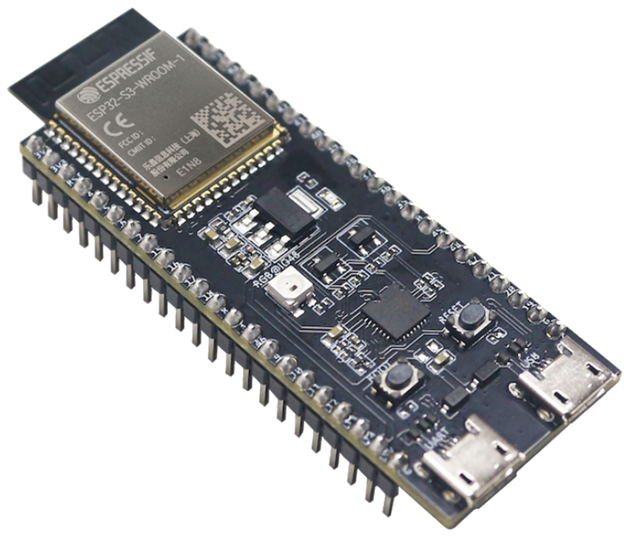The ESP32-S3 is a microcontroller unit (MCU) based on the Xtensa dual-core 32-bit LX7 processor architecture, which provides high processing power and advanced features such as hardware encryption acceleration and digital signal processing (DSP) instructions.
ESP32-S3 for AIoT Applications
Espressif’s ESP32 has been a popular choice for smart devices since its release in 2016, thanks to its Wi-Fi and Bluetooth connectivity, dual-core 240-MHz MCU, and computing power. This has allowed for innovative applications such as voice-interactive and machine-learning devices.
To further address the growing importance of AI in the IoT market, Espressif has introduced the ESP32-S3, a dual-core XTensa LX7 MCU running at 240 MHz with integrated Wi-Fi and Bluetooth 5 connectivity. The ESP32-S3 has 512 KB of internal SRAM, 45 programmable GPIOs, and supports a range of peripherals. Compared to the ESP32, it has larger and faster memory options with a configurable cache.
Wi-Fi + Bluetooth 5 (LE) Wireless Connectivity
The ESP32-S3 MCU is equipped with 2.4 GHz Wi-Fi (802.11 b/g/n) that supports a bandwidth of up to 40 MHz. Its Bluetooth Low Energy subsystem facilitates long-range communication through Coded PHY and advertisement extension, while the 2 Mbps PHY enables faster transmission speeds and better data throughput. Furthermore, the RF performance of both Wi-Fi and BLE remains excellent even in high-temperature environments.
AI Acceleration Support
The ESP32-S3 microcontroller unit is equipped with vector instruction support, which facilitates the acceleration of tasks involving neural network computing and signal processing. To further optimize these functions, software libraries are released.
These vector instructions are implemented in the MCU’s Xtensa LX7 processor, which includes a vector unit that can perform SIMD (Single Instruction Multiple Data) operations on up to 512-bit vectors.
The vector instructions in the ESP32-S3 MCU can accelerate the execution of various AI (Artificial Intelligence) algorithms, including neural networks and machine learning models. The vector unit can perform operations such as vector addition, subtraction, multiplication, and division, which are commonly used in AI computations. This can significantly improve the performance of AI applications running on the ESP32-S3 MCU, making it a suitable platform for AI-powered devices.
Rich Set of IO Peripherals
The ESP32-S3 MCU has a rich set of IO peripherals, including 45 programmable GPIOs, which is 10 more than those found in the ESP32. It supports commonly used peripherals like SPI, I2S, I2C, PWM, RMT, ADC, UART, SD/MMC host, and TWAITM. Furthermore, 14 of these GPIOs can be configured for capacitive touch input, making them ideal for HMI applications.
Additionally, the ESP32-S3 contains an ultra-low-power (ULP) core that has different operating modes such as low-power mode.
Security
ESP32-S3 offers built-in security features that are necessary for developing secure and connected devices, without relying on external components. Secure boot based on RSA and flash encryption based on AES-XTS is both supported by the ESP32-S3 MCU.
The ESP32-S3 MCU includes a digital signature peripheral and an HMAC module that functions similarly to a hardware secure element. These components protect against software attacks and identity theft by safeguarding private and symmetric keys.
Mature Software Support
Espressif’s ESP32-S3 MCU is well-supported by the company’s widely used ESP-IDF platform, which already powers numerous devices available in the market. ESP-IDF offers regular updates, thorough testing, and unparalleled support.
The ESP32-S3 platform can be seamlessly integrated with existing applications, or new ones can be developed using ESP-IDF’s reliable software architecture. This integration allows developers to utilize trusted ESP-IDF tools and APIs for a smooth transition to the new ESP32-S3 platform.
Applications of the ESP32-S3
ESP32-S3 is a dual-core microcontroller unit (MCU) that supports Wi-Fi and Bluetooth 5 (LE) connectivity, AI acceleration, a rich set of IO peripherals, and security features. It is designed for AIoT applications. Some possible applications of ESP32-S3 are:
- Smart Home Devices: The ESP32-S3 can be used to power various smart home devices such as smart lights, smart thermostats, smart plugs, and smart locks.
- Industrial Automation: Its powerful CPU and rich peripheral interfaces make it suitable for industrial automation applications such as remote monitoring and control, asset tracking, and equipment maintenance.
- HMI (Human Machine Interface) Applications: The ESP32-S3 is suitable for HMI (Human Machine Interface) applications, as it offers 45 programmable GPIOs, which is 10 more than the number available on the ESP32. Out of the total GPIOs, 14 can be configured as capacitive touch inputs, making it possible to implement touch-based interfaces for HMI applications.
- AI (Artificial Intelligence) Applications: For AI (Artificial Intelligence) applications, the ESP32-S3 MCU’s vector instructions can be utilized to accelerate neural network and signal processing workloads. This feature makes it well-suited for AI applications that require high performance.
- Wi-Fi and Bluetooth Connectivity: In addition to its 512 KB of internal SRAM, the ESP32-S3 MCU also includes integrated 2.4 GHz, 802.11 b/g/n Wi-Fi, and Bluetooth 5 (LE) connectivity. This feature offers long-range support and allows for seamless wireless communication.
Conclusion
The ESP32-S3 advanced processing capabilities, low power consumption, and advanced security features make it an ideal choice for IoT devices, wearables, smart home automation, industrial automation, and robotics applications. With several development tools available, including ESP-IDF, Arduino IDE, and PlatformIO, we can easily develop and deploy applications on the ESP32-S3.

